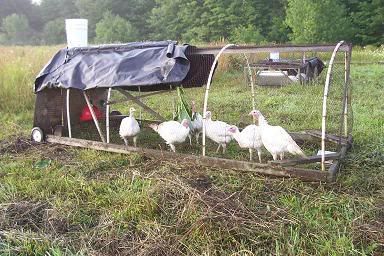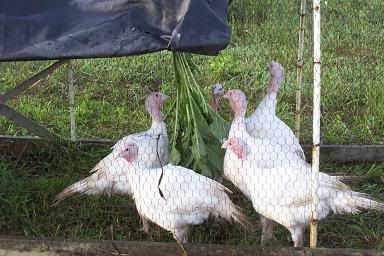
As mentioned in a previous blog entry, this is my first year raising turkeys. I started with 12. Two have died of undetermined causes. Neither bird appeared unhealthy. The losses were disappointing but not unexpected. They say that turkeys will die for no apparent reason. I’ve read that a 15% loss when raising turkeys is to be expected.
I was speaking with a neighbor last evening who is also raising turkeys for the first time. He had borrowed my Whizbang Chicken Plucker to process a batch of chickens. He is an organic dairy farmer. He is one of those who have a strong organic conviction because it is the right thing to do, not just because it has become more economically profitable in recent years. He told me he had some turkey losses too and started putting minced garlic in the bird’s water. There were no more problems after that. He also told me he uses things like garlic, cayenne pepper, castor oil, Echinacea and other herbs to heal his cows and boost their immune systems. I like to hear things like that, especially from a neighbor.
This neighbor is keeping his turkeys fenced inside a length of electric poultry netting from Premier. He moves the netting and birds to fresh pasture as needed. But he doesn’t have a charger to electrify the net. He said he couldn’t afford it. He uses the net only for containment of the birds and tethers his dog by the pen to deter predators.
I came very close to buying some of that same fencing this year, and a solar charger to keep it “hot” but I held off. It was going to cost several hundred dollars and I have read that keeping an adequate electric charge can be a bother.
So I opted to keep it simple. I put my ten turkeys in two old chicken tractors and I move them to a fresh patch of field twice a day. The turkeys are doing well. They are awesome grazers—far better grazers than chickens.
And I continue to be amazed at how much my turkeys like comfrey. I bring it to them in bunches and hang it for them to pick (as shown in the photo below). They will ignore their grain feed to eat the comfrey greens. I did a little research and found that comfrey is very high in protein. Fact is, it has almost the same protein content as soybeans!

I have four bush-like plantings of comfrey that I planted back in 1998. The rootstock was given to us by our homesteading friends and country neighbors Kathy and Jack who were part of a local Y2k “support group” we got involved with. It was Kathy and Jack who introduced me to the idea of growing garlic for its health benefits. And Kathy gave a soapmaking demonstration to our group, which eventually led to my wife, Marlene, starting her own handcrafted soap business. A lot of the things that are a big part of our way of life now began back when we were getting ready for Y2k. But I digress…
Until this year, have seldom used Kathy & Jack’s gift of comfrey. I’ve tried feeding it to chickens in the past but they are not as fond of it as the turkeys. But now, this year I wish I had more comfrey because I’ve fed most all of it to the turkeys, and they would be eating a whole lot more if I had it.
Comfrey is easy to grow. It grows like a weed. But it doesn’t spread like a weed. It doesn’t appear to be bothered by disease or bugs. My comfrey planting thrives in an area that gets only partial sun. As the cost of poultry feed costs go up, alternatives like comfrey have a lot more appeal. And there are more reasons besides turkey feed to have a LOT of comfrey growing on your homestead.
To learn more about comfrey, I encourage you to read this article by Nancy Bubel.
Every day when I feed and water my turkeys, I tarry to watch them. They are amazing, fun creatures. And as I see them growing bigger and fatter on grain and greens in the fresh air, I can’t help but think how nice it’s going to be to have one of them for Thanksgiving dinner. That’s the way it is when you raise animals for your own food. You look at the animal and see it on the table, feeding your family.
==============
P.S. If you have not yet read my other poultry-related essays, I invite you to do so. Here are the links...
Backyard Poultry Processing With My 11-year-Old Son
My Whizbang Plucker Story
Frequently Asked Questions About The Whizbang Plucker
Introducing My Deluxe Homemade Chicken Scalder
Talkin’ Bout My Chicken Tractors
FREE Chicken Feed
How To Butcher A Chicken
The Next Best Thing To A Whizbang Chicken Plucker
My Chicken Plucker Parts Business
The Best Place to Buy Plucker Fingers
























































































































6 comments:
Hi Herrick,
Friends of ours tilled around their comfrey plants (tilling up some smaller plants) and ended up with a whole garden of comfrey! Guess that is a good way to get it to grow. I've been harvesting ours for medicinal use, but guess we need to try it out on our turkeys. Thanks for the tip!
Comfrey is almost impossible to kill and you can get more plants by cutting up the roots and replanting them.
Comfrey Experiences.
I used to keep a little one acre homestead in Santa Barbara, California. Among the things I grew and used there was comfrey. It used to be called "bone break" because historically it was used to treat bruising and bone breaks, applied as a compress. It contains alantoin, which is a cellular proliferant, and casein, which helps to complete and balance protein rationing. I fed it to rabbits before and afer bearing, to increase milk flow, to my goats for the same reason, and because they really loved it, and for a while, before I read that the alantoin can accelerate cancers, drank it as a tea myself. Applied topically, it dramatically speeds closure of cuts. I had a Morgan Arab mare, then, named Teika. One day she got an overstep cut on a front fetlock, and I cleaned her up, put in some bacitracin to prevent infection, and bound on a gloopy compress of comfrey, with a gause pad next the wound, because comfrey, even crushed up, is hairy and irritating on skin. The next morning Teika had proud flesh projecting and bulging at least two inches beyond the wound lips. Horses grow fill-in tissue faster than skin tissue,, but this was rediculous. I had to pay a vet to come and sugically trim the proud flesh back and put in a couple of stitches. Comfrey is great stuff. Just don't use it on open wounds in horses!
To get new plants, take any root, slice it into dime-thick pieces, and each piece will grow in wet soil or a peat pot to give you a new plant. After some months in the ground, they are ready to start harvesting. Just pull the big outer leaves, strings wiil pull out of their bases. The roots can be dried and ground and used as a coffee substitute. That last big of lore I have from books, not personal experience.
Another plant I grew in the "healing grove", the shady, moist glade where I grew comfrey, was Angelica. Angelica Arcangelica is hard to find and get started,because the seeds lose 80% of their viability in just one year. However, Angelica will immediately and totally relieve acid stomach, soothe nausea, and diminishes or cures diarrhea. It even tastes good. We used to eat the celery-like stalks filled with peanut butter or my goat-milk cream sheese. I have used the juice of Angelica to treat topical pain of cuts, abrasions, and bee stings, with very good success in adults and children.
David Lloyd Sutton
i found this interesting that you use comfrey for feed. a few years ago i had a self- sufficient farm on 40 ac. i was learning all about all things farm and feed yourself- wonderful! well, i had free range chickens. next to my house, i had an herb garden that had comfrey in it. i noticed that the chickens didn't care for any herbs, but after flowering- or right at flowering- trying SO hard to remember what i thought at the time was a trival matter- now wishing i'd taken note... they would eat it down to the ground. it always grew back, and the cycle would continue. i didn't bother to keep them out of it because i assumed that if it healed or "made good strong bones" that i would want them to eat it, thinking it would perhaps increase the nutritional value of my stock after boiling their bones. now, i am VERY interested in planting this again... i have had to move to the city and have a chicken pen and garden just now up and going... this would be a good supplement for caged birds. thanks.
also, re: turkeys, i had a one yr experience with heritage turkeys right before i had to move, and i had them keeling over suddenly too... i read it can be heart issues. i started giving them olive oil daily in their water. biy, they loved to sip it out! and it took care of it. but i was frustrated because that makes for an expensive turkey! garlic would have been better perhaps?
thanks! keep posting!
and i thank God too, for your sons and their raising, this life needs more children RAISED. May God bless you and your family and keep you.
Texas
The article you linked to in Mother Earth News says comfrey is toxic for both humans and animals. So then... is it safe to feed to animals or not? I'm confused ;)
Comfrey has been fed to various farm animals for a very long time. I'm not qualified to say if it is safe or not. I've read both sides of the issue. Mother Earth news is, I'm sure, being careful because they don't want to be guilty of giving information that could be harmful. Neither do I. But I can say that I have no reservations personally about feeding the leaves to my poultry. I think the plant is very good for them, and they thrive by eating it. That's my opinion, for what it's worth.
Thanks for asking.
Post a Comment